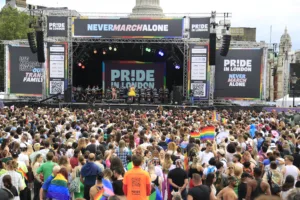By monthly NDA joint columnists Molly Towers Mode, Senior Associate Director at EssenceMediacom UK and Tatenda Nyamande, an Account Planner at EssenceMediacom.
Merry tokenism-mas
After reviewing over 40 Christmas ads from all the major advertisers in the UK, we have found no representation of the LGBTQIA+ community in any campaigns beyond 4 featuring ‘the G’.
These campaigns included either gay male talent, or a nod to romance between men, and no representation of the other identities that make up the LGBTQIA+ community.
The best examples of representation acknowledge that there is more to the LGBTQIA+ community than the gay male perspective, and in doing so are far more likely to win incremental audiences.
With Trans Visibility Week just gone (13th to 19th Nov), let’s take a look at adland’s Christmas offering through an LGBTQIA+ lens…
Putting the ‘G’ into Christmas
Waitrose ‘It’s time for the GOOD stuff’ and M&S ‘Love thismas (not thatmas)’ feature out gay talent Graham Norton and Queer Eye’s Tan France respectively, but are not using these celebrities to tell an LGBTQIA+ story.
Telling an inclusive romantic story are Walkers ‘Actually made for sharing’ with a male couple walking arm in arm, and ‘Fancy a McDonald’s this Christmas?’ spoofs Love Actually’s cards on the doorstep scene with two men. As representation goes, these are both great examples of bringing LGBTQIA+ couples to the screen and work within the over-arching idea of the ad.
Why does L BTQIA+ representation matter?
Positive representation in advertising is important for two reasons. Not only does it connect brands to a wider range of potential customers, but by showing diverse audiences in an empowered and respectful light, has the power to shift the cultural narrative and humanise marginalised groups.
A significant proportion (10.6%) of the population do not identify as straight, increasing for the youngest age groups, and it is important brands tune into these communities to reflect the make-up of the UK. With many festive campaigns using broad-reach strategies, simply reflecting the gay male perspective continues to perpetuate patriarchal structures that exist within the media landscape.
Female perspectives are often overlooked when it comes to LGBTQIA+ representation. The lived experiences of lesbians, bisexual and queer+ women differ massively from that of gay and male experiences. To adequately capture L BTQIA+ representation, brands need to do better than adhere to the male gaze.
During the recently ended Big Brother, one of Vinted’s sponsorship idents featured a non-binary perspective. Considering the youth skew for the programme, this was a smart move from the online marketplace, demonstrating they understand their audience.
Our Christmas Crackers
Sports Direct’s Christmas campaign encourages a girl to ‘Dream Big’ and features Alessia Russo and Lauren Hemp, among other sports stars. Sports Direct is actively supporting female participation in sports by encouraging girls to aspire to become professional athletes. There is a clear purpose for Sports Direct to lean into, and the narrative is powerful, tapping into the cultural shift supercharging growth around women’s sports.
JD’s ‘The bag for life’ reflects youth audiences using the bag as a common unifier. Breaking the negative tropes around youth in the UK, JD showcases “kids nowadays” in a positive light and gives them a chance to tell their stories. Whether it be young influencers, rising sports personalities, school kids expressing their dreams, or budding musicians, everyone is present, working hard, and has access to JD.
“Fear can easily be dispelled with education.”
Sainsbury’s 2020 Christmas ad caused a racist backlash by featuring a black family. All major UK retailers responded by running their ads back-to-back on Channel 4, calling to #StandAgainstRacism.
Advertising, particularly at Christmas, has the power to drive debate, inspire behaviour change, and take a stand for what is right. Fumi Olutoye argued at the time that “The supermarket’s decision to feature a family who just so happen to be black embraces the plurality of 21st-century Britishness.”
There is a fine line between representation and tokenism. An easy way for brands to win with more than the ‘G’ is ensuring those planning and activating campaigns come from these communities. Talent behind the camera is just as powerful as that in front of it.









